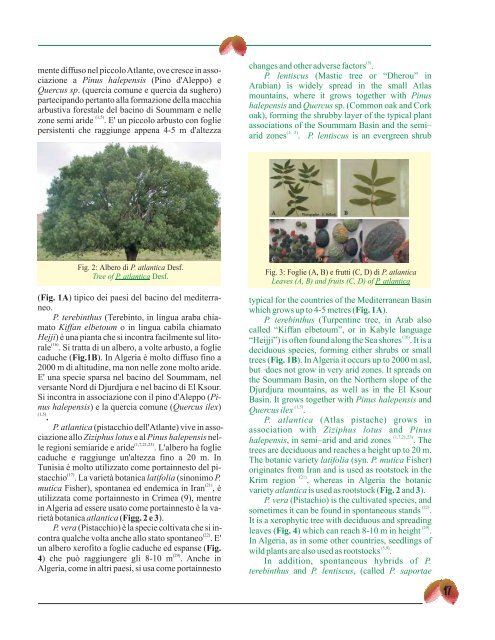Following Pistachio Footprints - Acta Horticulturae
Following Pistachio Footprints - Acta Horticulturae
Following Pistachio Footprints - Acta Horticulturae
Create successful ePaper yourself
Turn your PDF publications into a flip-book with our unique Google optimized e-Paper software.
mente diffuso nel piccoloAtlante, ove cresce in associazione<br />
a Pinus halepensis (Pino d'Aleppo) e<br />
Quercus sp.<br />
(quercia comune e quercia da sughero)<br />
partecipando pertanto alla formazione della macchia<br />
arbustiva forestale del bacino di Soummam e nelle<br />
(1,5)<br />
zone semi aride . E' un piccolo arbusto con foglie<br />
persistenti che raggiunge appena 4-5 m d'altezza<br />
Fig. 2: Albero di P. atlantica Desf.<br />
Tree of P. atlantica Desf.<br />
( Fig. 1A)<br />
tipico dei paesi del bacino del mediterraneo.<br />
P. terebinthus (Terebinto, in lingua araba chiamato<br />
Kiffan elbetoum o in lingua cabila chiamato<br />
Hejji)<br />
è una pianta che si incontra facilmente sul lito-<br />
(16)<br />
rale . Si tratta di un albero, a volte arbusto, a foglie<br />
caduche ( Fig.1B).<br />
In Algeria è molto diffuso fino a<br />
2000 m di altitudine, ma non nelle zone molto aride.<br />
E' una specie sparsa nel bacino del Soummam, nel<br />
versante Nord di Djurdjura e nel bacino di El Ksour.<br />
Si incontra in associazione con il pino d'Aleppo ( Pinus<br />
halepensis) e la quercia comune ( Quercus ilex)<br />
(1,5)<br />
.<br />
P. atlantica (pistacchio dell'Atlante) vive in associazione<br />
allo Ziziphus lotus e al Pinus halepensis nel-<br />
(1,7,21,23)<br />
le regioni semiaride e aride . L'albero ha foglie<br />
caduche e raggiunge un'altezza fino a 20 m. In<br />
Tunisia è molto utilizzato come portainnesto del pi-<br />
(17)<br />
stacchio . La varietà botanica latifolia (sinonimo P.<br />
(21)<br />
mutica Fisher), spontanea ed endemica in Iran , è<br />
utilizzata come portainnesto in Crimea (9), mentre<br />
in Algeria ad essere usato come portainnesto è la varietà<br />
botanica atlantica ( Figg.2e3).<br />
P. vera (Pistacchio) è la specie coltivata che si in-<br />
(22)<br />
contra qualche volta anche allo stato spontaneo . E'<br />
un albero xerofito a foglie caduche ed espanse ( Fig.<br />
(29)<br />
4)<br />
che può raggiungere gli 8-10 m . Anche in<br />
Algeria, come in altri paesi, si usa come portainnesto<br />
(5)<br />
changes and other adverse factors .<br />
P. lentiscus (Mastic tree or “Dherou” in<br />
Arabian) is widely spread in the small Atlas<br />
mountains, where it grows together with Pinus<br />
halepensis and Quercus sp. (Common oak and Cork<br />
oak), forming the shrubby layer of the typical plant<br />
associations of the Soummam Basin and the semi–<br />
(1, 5)<br />
arid zones . P. lentiscus is an evergreen shrub<br />
Fig. 3: Foglie (A, B) e frutti (C, D) di P. atlantica<br />
Leaves (A, B) and fruits (C, D) of P. atlantica<br />
typical for the countries of the Mediterranean Basin<br />
which grows up to 4-5 metres ( Fig. 1A).<br />
P. terebinthus (Turpentine tree, in Arab also<br />
called “Kiffan elbetoum”, or in Kabyle language<br />
(16)<br />
“Heijji”) is often found along the Sea shores . It is a<br />
deciduous species, forming either shrubs or small<br />
trees ( Fig. 1B).<br />
InAlgeria it occurs up to 2000 m asl,<br />
but does not grow in very arid zones. It spreads on<br />
the Soummam Basin, on the Northern slope of the<br />
Djurdjura mountains, as well as in the El Ksour<br />
Basin. It grows together with Pinus halepensis and<br />
(1,5)<br />
Quercus ilex .<br />
P. atlantica (Atlas pistache) grows in<br />
association with Ziziphus lotus and Pinus<br />
(1,7,21,23)<br />
halepensis,<br />
in semi–arid and arid zones . The<br />
trees are deciduous and reaches a height up to 20 m.<br />
The botanic variety latifolia (syn. P. mutica Fisher)<br />
originates from Iran and is used as rootstock in the<br />
(21)<br />
Krim region , whereas in Algeria the botanic<br />
variety atlantica is used as rootstock ( Fig. 2 and 3).<br />
P. vera (<strong>Pistachio</strong>) is the cultivated species, and<br />
(22)<br />
sometimes it can be found in spontaneous stands .<br />
It is a xerophytic tree with deciduous and spreading<br />
(29)<br />
leaves ( Fig. 4)<br />
which can reach 8-10 m in height .<br />
In Algeria, as in some other countries, seedlings of<br />
(5,9)<br />
wild plants are also used as rootstocks .<br />
In addition, spontaneous hybrids of P.<br />
terebinthus and P. lentiscus, (called P. saportae<br />
17

















